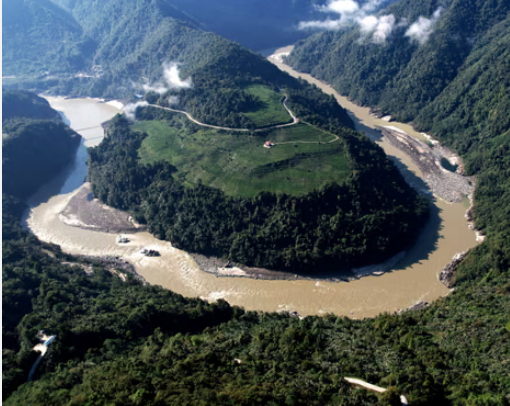Nuclear fusion breakthrough: China’s ‘artificial sun’ reactor sets a new world record by generating a steady loop of plasma for 1,066 seconds - taking the world closer towards limitless clean energy
If we want to rely on nuclear fusion to power the world's homes, the first step is making reactors that can run as hot and as long as possible.
Now, China's 'artificial sun' reactor – officially called 'Experimental Advanced Superconducting Tokamak' (EAST) – has set a new world record, bringing the goal of limitless clean energy ever closer.
The reactor, located in Hefei in Anhui province, generated a steady loop of plasma for 1,066 seconds at 180million°F (100million°C) – seven times hotter than the sun's core.
It surpasses the previous world record of 403 seconds, also set by EAST in 2023.
EAST could be a precursor to the first ever fusion power plants that supply power directly to the grid and electricity to people's homes.
These power plants could reduce greenhouse gas emissions from the power-generation sector by diverting away from the use of fossil fuels like coal and gas. Fusion differs from fission (the technique currently used in nuclear power plants), because the former fuses two atomic nuclei instead of splitting one (fission).
Unlike fission, fusion carries no risk of catastrophic nuclear accidents – like that seen in Fukushima in Japan in 2011 – and produces far less radioactive waste than current power plants, its exponents say.
China's 'artificial sun' is operated by the Institute of Plasma Physics (ASIPP) at Hefei Institutes of Physical Science on behalf of the Chinese Academy of Sciences.
The new world record, achieved on Monday, marks a critical step toward a functional fusion reactor, according to ASIPP director Professor Song Yuntao.
'A fusion device must achieve stable operation at high efficiency for thousands of seconds to enable the self-sustaining circulation of plasma, which is essential for the continuous power generation of future fusion plants,' he said.
Global scientists have worked for more than 70 years on trying to achieve this feat, according to a release from State Council Information Office, central propaganda department of the ruling Chinese Communist Party.
Gong Xianzu, head of the division of EAST physics and experimental operations, said they have upgraded several EAST systems since the last round of experiments.
For example, the heating system, which previously operated at the equivalent of nearly 70,000 household microwave ovens, has now doubled its power output.
'The ultimate goal of an artificial sun is to create nuclear fusion like the sun, providing humanity with an endless, clean energy source,' the release says.
Fusion – generally considered the holy grail of energy – could also enable 'space exploration beyond the solar system', by providing rockets with more powerful propulsion systems.
At the heart of EAST and other fusion reactors around the world is a tokamak, a doughnut-shaped device initially conceptualised in the 1950s by Soviet physicists.
Inside, under the influence of extreme heat and pressure, gaseous hydrogen fuel becomes a plasma – a hot, electrically charged gas.
Plasma is often referred to as the fourth state of matter after solid, liquid and gas, and comprises over 99 per cent of the visible universe, including most of our sun.
In the tokamak, the plasma is trapped and pressurised by magnetic fields until the energised plasma particles start to collide.
As the particles fuse into helium, they release enormous amounts of energy, mimicking the process that occurs naturally in the centre of stars like our sun. The only by-products of fusion reactions are small amounts of helium, an inert gas which can be safely released without harming the environment.
As a result, fusion reactors have long been touted as the best clean energy source – although the Bulletin of the Atomic Scientists claims they are 'far from perfect'.
As yet, the energy input required to produce the temperatures and pressures that enable significant fusion reactions in hydrogen isotopes don't justify the fusion energy that's actually being generated, the nonprofit organization points out.
It's worth bearing in mind that EAST, as the name suggests, is China's 'experimental' reactor project – and may yet pave the way for the first nuclear fusion power plants.
Chinese experts say: 'The mission of the EAST project is to develop an advanced fully superconducting tokamak so as to establish solid scientific and technological bases for the future continuous operation of tokamak fusion devices.'
Of course there are already nuclear power plants around the world, but they use nuclear fission, which has the disadvantage of generating unstable nuclei, some of which are radioactive for millions of years.
Fusion, on the other hand, does not create any long-lived radioactive nuclear waste but instead helium, which is an inert gas. Fusion fuel is made up of deuterium and tritium, which are isotopes of hydrogen, the most abundant element in the universe, giving scientists hopes of 'unlimited energy'.
The Chinese team plan to use the nuclear fusion reactor in collaboration with scientists in France working on the International Thermonuclear Experimental Reactor (ITER).
The Provence-based ITER project is expected to begin delivering power in 2035, and will become the world's biggest reactor once completed.
Mail Online
Source: Myawady Daily Newspaper




 ,
, 
 ,
, 


